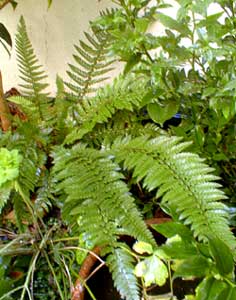
Long-eared Holly Fern
"Once only have you spoken, when the lark
Whirred from among the fern beneath our feet,
And I, no coward in my better days,
Was almost terrified."
-William Wordsworth
1770-1850
1770-1850
The genus Polystichum provides some of the prettiest, most persistantly evergreen ferns, including the tremendous Japanese Tassel Fern (P. polyblepharum); our own locally native Western Sword Fern (P. munitum); & the present example, the Long-eared Holly Fern (P. neolabatum).
The species was introduced to western gardening many years ago by the late Dr. Z. Seibert of Czechlosovakia. The English common name was apparently bestowed upon this fern more recently, by grower Judith Jones of Fancy Fronds Nursery here in Washington state, & she had the long-eared owl partly in mind.
"Long-eared" name refers to the ear-like pinnule at the tips of young leaves. The "Holly Fern" name, for being evergreen, seems less apropos, as this common name is so much more applicable to the genus Cyrtomium which has holly-like leaves.
Long-eared Holly Fern is one of the hardiest of a hardy genus & achieves the highest ideal of year-round ornamentality. On Puget Sound its glossy leaves are impervious to winter, making a good impression when other ferns have either died back until spring or have at least getting tattery. It remains strongly upright even in snow.
This native of Nepal, Tibet, Burma, China, Japan & Taiwan, is becoming rare over much of its range due to over-collection of such a garden-worthy species. For this reason it should be obtained from legitimate growers who do not get their plants as imports taken from the wild.
It grows two to three feet high & is hardiest in zones six through eight, surviving temperatures as low as minus 20 degrees F.
The tough shiny leaves acquire a silvery sheen as they age. The clump wants partial to nearly full shade in moist soil with good drainage. With extremely persistent moisture, it can tolerate quite a bit more sun than the majority of ferns, though some shade, where its water needs would not be as great, would be preferable.
The photograph above was taken in August 2004 during its second year in the garden, still young but already showing a broad arching aspect.